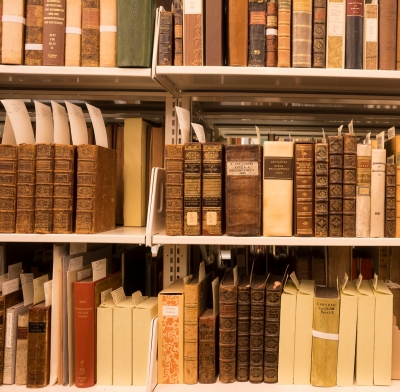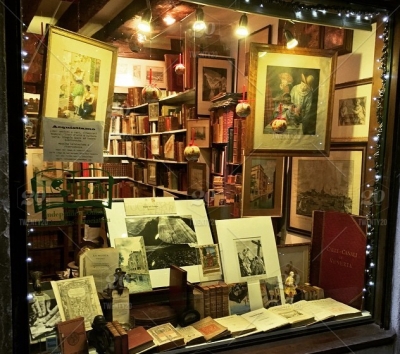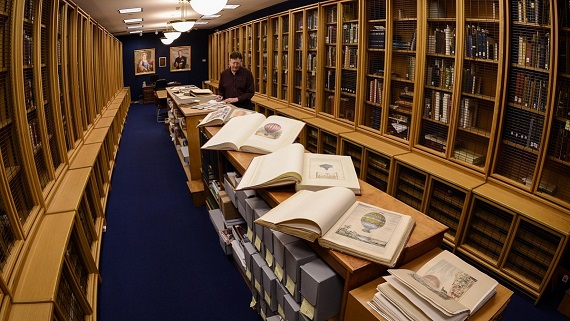Information on Old Books
Preservation and Handling
Shelving and Storage
In general, old books are best suited to a cool, dark environment (around 65-70 degrees with about 45% relative humidity). If you keep your books in the basement (usually too damp) or in the attic (often too hot and dry) you may want to re-think your storage.
Books are made of organic material and are easily affected by their environment. Rather than keeping them stacked in air-tight containers, store your books standing upright, fully supported and away from acidic materials like newspapers.
Book Cleaning
It’s possible to clean your books safely! To remove dust, hold your book firmly closed and use a clean cloth to lightly brush along the text block, directionally away from the spine. You can also vacuum your books using a vacuum hose. Place a piece of cheese cloth over the end of the hose and secure with a rubber band to ensure no loose bit of books are picked up and lost. Hold your book firmly closed and gently run the vacuum over the text block edges directionally away from the spine.
It is best to leave any cleaning of the interior of the book to professionals.
Handling
Books are designed to be handled, but incorrect handling over long periods of time can cause harm. A book should never be pulled from the shelf by the top of the spine (the headcap), as the headcap will eventually tear and cause damage to the rest of the spine. To avoid pulling on the headcap, reach over the top and push the book slightly forward from the back, or push in the books on either side to allow a firm grasp on the middle of the spine.
Though we all love finding little mementos in our books, it is best not to place foreign objects between pages. Thick items could warp and break the book’s structure when the book is closed, and materials like newspaper clippings and post-it notes may stain the pages.
Preservation
If your book is already in need of care, do keep any pieces that have become detached. Books with detached covers can be tied like a present with white cotton book tape with the bow on top of the text block edge. The book can be shelved as if the covers were still attached. Though the Smithsonian Libraries does not endorse any individual company, here are some resources to get you started with preservation supplies:
Repairs and Conservation
Do not attempt to tape any part of the book if you want to maintain its historic or monetary value. Please consult a professionally trained book conservator for recommended treatment options.
As mentioned above, books are made of organic materials and often show their age. The deterioration of the material may be slowed but can rarely be reversed to create a brand-new looking book. Beware of promises of rejuvenation by restorers! Such treatment is not only difficult to achieve, it often erases features important to understanding the history of the book and can negatively impact its historic and monetary value.
The American Institute for the Conservation provides information on caring for your collections and a offers a referral service to connect you with book conservators in your area for professional advice.
Appraisals
The Smithsonian Libraries does not provide appraisals of old books.
- The Antiquarian Booksellers Association of America Booksellers (ABAA)
- The American Society of Appraisers Find an Appraiser (ASA)
- The Appraisers Association of America Find an Appraiser
- The International Society of Appraisers (ISA) Find an ISA Member
A formal appraisal will cost money and may be necessary for certain situations (insurance coverage and claims, tax deductions, etc.), but for many other purposes you can look up useful information about your book(s) on your own using sources that are available on the Internet and in public and academic libraries.
Do It Yourself
Identifying Your book
The first step is to identify your book. The key information that you’ll need is on the title page of the book – not the dust jacket, the front cover, or the half-title – and for modern books its back side, called the copyright page.
The title page will give you the author’s name, the full title, and the imprint (the city, publisher, and date); it will also usually state the edition if it’s anything other than the first. The copyright page will usually provide the date the book was registered for copyright (not necessarily the same as the publication date on the title page) and coded information about which edition and printing your copy is. That’s important for collectible modern literature, for example.
Frequently asked questions: Is it a first edition? A revised and corrected edition? Is it a limited edition, possibly scarce, or is it common and easily available? These factors will influence the book’s market value and, if you want to sell or donate it, whether any particular collector or library needs it.
To determine the publication history of the work and where your book fits into it, you can consult catalog resources and author/subject bibliographies. Some of these are accessible on the Internet while others are available only in print at public or academic libraries.
Catalogs
-
WorldCat/OCLC: a catalog developed as a computer database to which thousands of libraries in the U.S. and around the world contribute records. This database is freely accessible online.
-
The National Union Catalog: Pre-1965 Imprints (NUC): available in print or on microfiche, is a published version of the combined card catalog of several hundred libraries in the U.S., including the Library of Congress.
There will be a separate listing for each known or suspected edition of your book, and you should be able to match yours with one or another of these records on the basis of the imprint (city, publisher, date) and edition statement. Be very careful to find an exact match, so that you have an accurate identification of your book and know where it fits in the work’s publication history. Each listing in these catalogs includes the libraries that have a copy of the book, and this can give you first, a preliminary idea of how scarce or common the book is, and second, libraries to contact for bibliographic information about the book.
Author and Subject Bibliographies
There are printed bibliographies for many specific authors and subjects, consisting of detailed lists of every edition of every title ever published by that author or on that subject. These bibliographies can usually be found in the reference section of public and academic libraries or looked up in the library’s online catalog; some may be available online from cover to cover. The compilers of these bibliographies have searched the National Union Catalog and WorldCat, as well as other sources, and present you with the whole publication history neatly summarized. Then, as above, you would find the listing that matches your book exactly (by imprint and other descriptive information). In addition, of course, there are many websites devoted to particular authors or subjects that you can find through Google or other search engines.
It may be helpful to consult with libraries or bookdealers who specialize in relevant fields. For bookdealers, go to the Antiquarian Booksellers Association of America (ABAA) to find Booksellers and search by state, region or speciality. The ABAA membership directory is also available in print, with geographical and subject indexes.
To find libraries that specialize in the appropriate subject, consider those listed as having the book in the National Union Catalog and WorldCat records that you found, or consult the following books, which, though old may still be useful:
Lee Ash and William G. Miller, compilers. Subject collections: A guide to special book collections and subject emphases as reported by university, college, public, and special libraries and museums in the United States and Canada (7 th ed. New Providence NJ: Bowker, 1993).
Modoc Press, compiler. Special collections in college and university libraries (New York: Macmillan, 1989).
Determining Completeness and Condition
The monetary and research value of a book depends in large part on whether it is complete and in good condition.
The records in the bibliographic sources listed above for identifying your book (National Union Catalog, WorldCat, author and subject bibliographies, etc.) will give you information on how many pages, and sometimes how many illustrations (sometimes identified as “plates” when they are on separate leaves from the text), your book should have. If any are missing, your book is incomplete.
A book’s condition is determined by its physical characteristics: Is the cover faded, stained, detached, or missing? Are the pages loose, dog-eared, stained, or torn? These may not dis-qualify an old book from being useful and even valuable, but they may down-grade its value compared to ones in better condition. For a helpful glossary of terms describing a book’s physical condition, see Robert F. Lucas’s Essentials of book collecting…pt.4 Jargon - Condition and its importance.
Finding Your Book’s Market Value
For tax or insurance purposes, valuations must be made by an expert such as an antiquarian or specialist bookdealer who knows the current market.
About market values, a word of caution: the monetary value of a book is what someone else is willing to pay for it . The demand for any particular author or title may fluctuate up and down over time. In addition, any individual copy's value will vary on the basis of its edition, scarcity, condition, completeness, and association. Any valuation or appraisal is an educated guess, applicable only to a specific copy at a specific moment in time.
There are many published price guides for popular and collectible subjects that attempt to list current rates at the time of publication. Such guides can usually be found in your local library or in the Reference or Collectibles sections of bookstores. Up-to-date information is crucial - be sure to use only the most current or recently published guides.
For current prices, the following websites may be useful: AbeBooks, ViaLibri, AddALL. These sites serve as a vehicle for booksellers across the world to advertise and sell their wares. It is often useful to compare your own book to those up for sale, using the condition notes listed for each book to determine whether it is an approximate match for your own book.
There may be no listings for the books you have. This sort of negative evidence is ambiguous; there is no way to know whether this is because the book has not come up for sale (and may therefore be scarce), or because of low value and lack of interest.
Selling Your Book
If you would like to sell your book, please refer to the Appraisals section above for suggestions. An alternative to using a book dealer is selling it yourself via any popular website, such as Amazon, AbeBooks, Ebay and others that allow individuals to put their book up for sale on the internet. The Smithsonian Libraries and Archives is not able to participate in any way in the sale of an individual’s material.
Finding a Home for Your Book
There are many ways to ensure your book finds a good home. Your local public library is one option for donating books in good condition that could be used by the general public. There are also community book collection drives for shelters, schools, and other non-profits that could benefit from your books. If you are interested in donating to the Smithsonian Libraries and Archives, please see the procedures outlined below.
Donations
The Smithsonian Libraries and Archives considers donations in specific fields of interest: the history of science and technology, the natural sciences, American history (including Native American, African-American, Latino-American, and Asian Pacific Amerian cultures), the history of aeronautics and space exploration, the history of the decorative arts, and various areas of art and art history.
Donors are recognized with a bookplate in the volume(s) and are listed in the Libraries and Archives’ and the Institution’s annual reports. Appraisals, if needed for tax or legal purposes, are the responsibility of the donor; go to Appraisals for information on finding a qualified expert.
We will be happy to provide information and help with the donation process. See our Gifts-in-Kind Policy for more information and Contact Us with as much information about the book(s) as you can gather.







